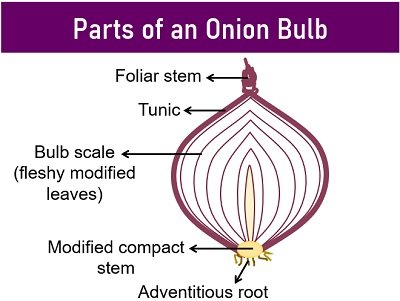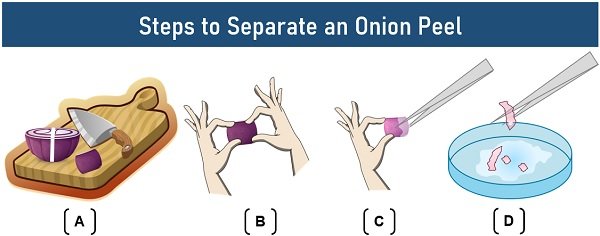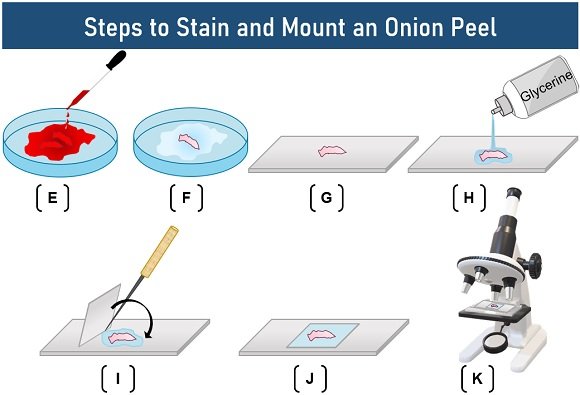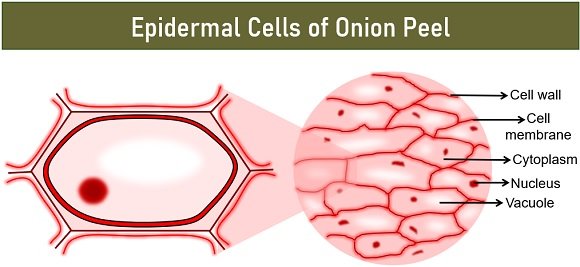The onion peel cell experiment is very popular for observing a plant cell structure. Onion is a eukaryotic plant that contains multicellular cells. We know that the cell is a structural and functional unit of life that builds up living structures.
The bulb of an onion is formed from modified leaves. Like plant cells, onion cells have a rigid cell wall and a cell membrane enclosing the cytoplasm and nucleus.
Onion epidermal cells exist as a single layer that serves as a protective skin. It separates the thick, juicy scale leaves of the onion. Thus, the bulb of onion is formed from modified leaves.
The epidermal cell of an onion bulb is simple and transparent. Its microscopic observation introduces the general view of plant anatomy to the students.

Firm and medium-sized onions are generally used to visualize the onion’s epidermal cells. This post explains the theory, requirements, and procedure of the onion peel experiment. Also the observation, result and precautions of the experiment are also discussed.
Content: Onion Peel Cell Experiment
Objective
The main objective of performing the onion peel cell experiment is to observe the arrangement and structural components of the onion epidermis. The following facts about the onion peel cell experiment play a significant role in educating students:
- The epidermis of the onion bulb is a single layer of tissue that is easy to separate. For this reason, onion peel is best for educational and experimental purposes to study the structure of plant cells.
- Due to the large size of onion cells, the cells can be examined under low magnification.
- It is also a simple experiment that the students can efficiently perform, plus they can practice how to use a microscope.
Requirements
We need the following glassware and reagents to prepare a temporary slide of an onion peel.
Materials required to separate onion skin
- Medium-sized onion
- Knife
- Forcep
Materials needed to stain and mount the onion peel
- Petri Plate
- Distilled Water
- Safranin
- Clean glass slide
- Glycerine
- Coverslip
- Blotting paper
- Compound microscope
Theory
An onion is a multicellular plant. The presence of a rigid cell wall and a large vacuole is a characteristic feature of a plant cell. Thus, onion being a plant, comprises features common to plant cells. Like plant cells, onion cells consist of a cell wall and cell membrane surrounding the cytoplasm, nucleus and a large vacuole.
- The cell wall is a rigid, protective coat covering the cell membrane, including all the internal components. The rigid cell wall maintains the shape of onion cells and contributes to the compact arrangement of the epidermal cells in onion.
- The cell membrane is interior to the cell wall surrounding the cytoplasm, including all the internal structures.
- The cytoplasm is the cell’s inner space that appears jelly-like. It moves the cytosolic material around the cell through cytoplasmic streaming.
- The nucleus is present near the periphery of the cytoplasm. It is the control centre of the cell and the largest organelle in the cell.
- The vacuole is large and prominently seen at the centre of the cell. It stores solid and liquid contents. The basic shape or size of a vacuole differs depending on the needs of the cell.
Video: Onion Peel Cell Experiment
Procedure of Onion Peel Cell Experiment
The steps to perform the onion peel cell experiment are as follows:

Steps to separate an onion peel
A. Take an onion, separate its outermost peel and chop it into two equal halves.
B. Then, take one fleshy scale leaf of a chopped onion bulb and split it into two.
C. Then carefully pull a thin, transparent epidermal peel from the convex surface of the scale leaf using forceps.
D. Then, wash the separated peel in the Petri plate containing water. You can cut the onion peel into small rectangular pieces using a blade.

Steps to stain and mount an onion peel
E. After that, transfer the onion peels into the Petri plate containing diluted safranin stain. Leave the peels undisturbed for about 3 minutes.
F. Finally, rinse the extra stain of the peel by again dipping it in the Petri plate containing water.
G. With the help of a brush or forcep, transfer the peel to the centre of a clean glass slide.
H. Then, to mount the onion peel, add a drop of glycerine over the centre of the slide. Glycerine prevents the peel from drying up.
I. After that, carefully mount a cover slip over the centre of the prepared slide by slowly lowering it with a needle. During this stage, you need to avoid the entry of any air bubbles.
J. Using a piece of blotting paper, remove extra glycerine from the margins of a cover slip.
K. Observe the temporary slide under the compound microscope.
- First, turn on the microscope’s light and ensure the low objective lens is in line with the optical tube. Then, place the prepared slide on the stage of a microscope.
- Looking from the side (not through an eyepiece), lower the tube using the coarse focus knob until the end of the objective lens is just above the cover glass. During this stage, do not crack the cover glass, or the objective lens may get damaged.
- Now look through the eyepiece and adjust the smaller, fine focusing knob to move the optical tube upwards until an image comes into focus.
- Then, swap the objective lens to a high objective lens so that you can notice the cells at greater magnification.
- Prepare an observation table for the cells as seen under a microscope and note the features listed in the observation table.
Observation
- Shape of cells: Rectangle
- Arrangement of cells: Compact
- Inter-cellular spaces: Absent
- Nucleus: Present (at the cell’s periphery)
- Stained portions: Cell wall and nucleus are darkly stained with less-stained cytoplasm
- Unstained portions: Cell membrane and Vacuole
Result
Onion epidermal cells are rectangular and compactly arranged (with no intercellular spaces). There is a distinct cell wall, a prominent nucleus and a vacuole.

Precautions
- Do not overstain the onion skin.
- Avoid the folding of the peel.
- The glass slide and cover slip should be dry and clean.
- Put a coverslip carefully to avoid any air bubbles.
- Using blotting paper, remove the extra glycerine.
Conclusion
Therefore, the onion peel cell experiment is an engrossing activity that can help a student to observe and study the plant cell structure. Students can prepare the temporary slide and observe the differences between the slide with stained onion skin and the slide without any stain. The microscopic observation of onion peel cells will allow students to closely examine each component of onion cells.
Thank you for the details on this experiment.